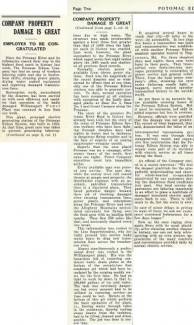Collection Name
About
POTOMAC EDISON NEWS
APRIL 1936
COMPANY PROPERTY DAMAGE IS GREAT
EMPLOYES TO BE CONGRATULATED
Since the Potomac River and its tributaries roared their way to the highest flood mark in history last week, The Potomac Edison Company has had an army of workers laboring night and day in twelvehour shifts, cleaning power plants, drying water soaked equipment and repairing damaged transmission lines.
Restoration work, necessitated by the disaster, has been carried on with such efficiency and rapidity that operation of the badly damaged Williamsport Power Plant was resumed in less than one week.
This plant, principal electric generating station of the Potomac Edison System, was built in 1923. At that time, great care was taken to prevent generating interrup-
(Continued on page 2, col. 1)
tions due to high water. The structure was made invulnerable against a level three feet greater than that of 1889 when the highest mark in history was reached. Last week, however, the plant succumbed to the Potomac River which raged seven feet eight inches above the 1889 mark and shattered all previous flood records.
Normally, electric power is available from eleven power stations. Such was the magnitude of the recent disaster and so widespread its effects that at one time, only one of the Potomac Edison stations was able to generate current. To date, normal operation has been resumed at all stations with exception of the badly damaged plants at Dam No. 4, Dam No. 5 and Great Cacapon along the Potomac.
The story of the greatest Potomac River flood in history has already been told, but the story of the corps of Potomac Edison System workers who have been fighting through sleepless days and nights in water and in darkness, in dangerous flying weather and in the face of reports of on coming catastrophe—remains untold.
Reports that the once placid Potomac was on a rampage, after winter thaws of the north, first came one night. Power Company executives went into immediate action.
Every available man was pressed into service. The next day, while the unruly river still roared threats at people and property, the distribution engineer with an assistant, patrolled transmission lines in a chartered plane. They faced potential danger because their job of checking damaged river crossing transmission lines, power plants and substations along the Potomac River and over the Allegheny Mountains necessitated extremely low flying over the flood area with no landing field nearby. They flew 550 miles like that, and accurately charted every line break.
This information was rushed to the Line Superintendent, who initially pressed into service leaky motor boats to drag new transmission lines across the treacherous river.
Almost simultaneously a professional diver was rushed to the Williamsport plant. His was the hazardous job of removing condenser water drain plates at the bottom of the seventy-two foot condenser pit which had been inundated by the surging muddy water for the first time. He had no light to work by down in that 3,200,000 gallons of icy cold water. The task was extremely dangerous but every moment had to be utilized in restoring service—no time could be lost. Motors at the bottom of this pit which perform the basic operation of the plant, i.e., forcing water through tubes in the condenser, thereby cooling steam drawn from the turbines, had to be lifted, cleaned and dried, quickly. The job was done in record time.
It required several hours to reach that city—26 miles to the west—by automobile. In less than five hours a transmitter was built and communication was established with another Potomac Edison amateur operator located in Hagerstown, Md. For three sleepless days and nights these men were loyal to their posts. They transmitted over forty-two-way messages pertaining to restoration of power service and general relief. There, from the local power company's office, straining his eyes under flickering candle light, a haggard, nerve racked operator transmitted history to the outside world.
As yet there is no accurate figure available covering losses of the Potomac Edison System. But it must be enormous, not only in added expense but loss in revenue.
However, officials were gratified that the damage was not greater. The record of what happened, they said, demonstrated the value of an interconnected transmission system. It was only through this comparatively recent and expensive line construction that the Potomac Edison System was able to supply some part of its territory with electric service at all times during the flood.
An official of the Company stated in a recent interview: "We feel the deepest gratitude for the sympathetic understanding and cheerful whole-hearted co-operation manifested by our customers during the disastrous flood conditions just past. Our local service departments are laboring ceaselessly in an effort to place a multitude of damaged household electric appliances back in use. There is still much to do, but the worst is over.
In case of minor delays in getting to some of these, we ask our customers' continued forbearance for a few days longer."
Now as the once raging river again flows with its usual placidity, after claiming another chapter in history, one can not help retrospecting with an even greater appreciation of the many comforts and conveniences provided daily by normal electric service.
